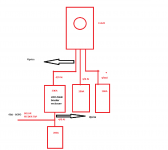I am attaching a pictorial representation of a scenario where the solar point of interconnection is proposed to be on the load side feeders of one of the panels.
According to 705.12(A)(2)(b), we are permitted to perform a feeder tap on the existing 4/0Al feeders as long as we install an OCPD on the load side to ensure that the current does not exceed 200A.
However, the AHJ is requiring both the service and feeder wires to be upsized, citing nonconforming service conductors from the meter to the main that do not meet the requirements of 310.12(A) or (B) for feeding the entire load. As we are performing a feeder tap, the AHJ is requiring us to upgrade the service conductors and feeder to meet 310.16 and 705.12(A)(2)(B).
I don't think this is the correct interpretation of the code and should not require the upsizing of the conductors. The key issue is that the city is requiring the service and feeder conductors to be rated for the entire house load ( let's say it's at 320A) rather than just handling 200A to loads specific to the panel. However, 310.12(A) does not explicitly state that feeders must be rated for the entire load; instead, it permits feeders to be sized ( 83%) based on their association with the entire load, which implies that they can be part of, but not necessarily equal to, the entire load.
Please let me know your thoughts.
According to 705.12(A)(2)(b), we are permitted to perform a feeder tap on the existing 4/0Al feeders as long as we install an OCPD on the load side to ensure that the current does not exceed 200A.
However, the AHJ is requiring both the service and feeder wires to be upsized, citing nonconforming service conductors from the meter to the main that do not meet the requirements of 310.12(A) or (B) for feeding the entire load. As we are performing a feeder tap, the AHJ is requiring us to upgrade the service conductors and feeder to meet 310.16 and 705.12(A)(2)(B).
I don't think this is the correct interpretation of the code and should not require the upsizing of the conductors. The key issue is that the city is requiring the service and feeder conductors to be rated for the entire house load ( let's say it's at 320A) rather than just handling 200A to loads specific to the panel. However, 310.12(A) does not explicitly state that feeders must be rated for the entire load; instead, it permits feeders to be sized ( 83%) based on their association with the entire load, which implies that they can be part of, but not necessarily equal to, the entire load.
Please let me know your thoughts.

